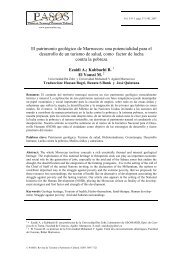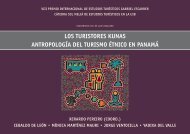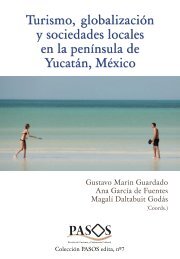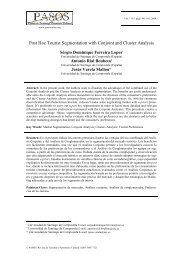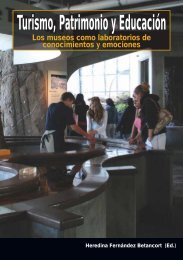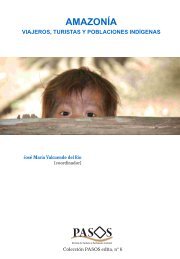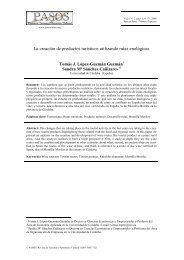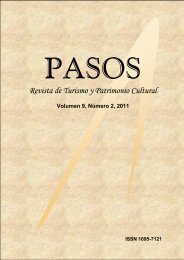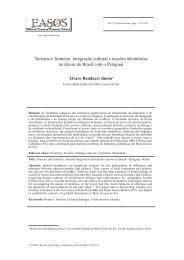Full Journal - Pasos
Full Journal - Pasos
Full Journal - Pasos
You also want an ePaper? Increase the reach of your titles
YUMPU automatically turns print PDFs into web optimized ePapers that Google loves.
Josep-Francesc Valls; Silvia Banchini; Luis Falcón; Gerard Valls Tuñon 95<br />
by city, determines the positioning of each<br />
metropolis compared to the synthetic index,<br />
The Tourism Innovation Capacity Index of<br />
Barcelona, 2008.<br />
As for the list of cities chosen, it was<br />
taken from a study in which these top ten<br />
cities were ranked as being the most attractive<br />
in Europe (Sureda, Valls, 2008).<br />
The competitiveness strengths were<br />
linked to demographic factors and tourist<br />
numbers and their growth over the period,<br />
and in particular the emergence of six pay<br />
sights attracting over 1.3 m visitors a year.<br />
This represented high tourism productivity<br />
in such a small area. The main weaknesses<br />
covered: some of the regional and economic<br />
indicators; air and high-speed rail links<br />
(especially when it came to inter-modal<br />
transport); a creative society in terms of both<br />
training and output; the information society.<br />
Despite the persistence of these weaknesses,<br />
Barcelona rose to third position in the index,<br />
coming some way behind Paris and London<br />
but slightly ahead of Frankfurt, Berlin and<br />
Madrid. Before beginning its programme for<br />
tourism development fifteen years ago, Barcelona<br />
was not among the 15 main European<br />
cities listed in this index. Crossing the creative<br />
society and transport connection factors<br />
with tourism competitiveness (Figures 2 and<br />
3), shows the main strengths lie in tourism<br />
competitiveness and the main weaknesses in<br />
transport connections and a creative society.<br />
The indicators reveal excellent positioning,<br />
which is the fruit of a great deal of<br />
planning to overcome the city’s uncompetitive<br />
situation one and a half decades ago.<br />
Figure 2: Barcelona’s positioning regarding<br />
Creative Society/Tourism Competitiveness<br />
compared with ten European cities<br />
Source: ESADE-Intelligent Coast, 2008<br />
Figure 3: Barcelona’s positioning<br />
regarding Transport Connections/Tourism<br />
Competitiveness: comparison with ten<br />
European cities<br />
2.3. Vision of internal players<br />
The growth of city tourism is viewed as<br />
a success by internal players (70%), though<br />
30.8 % consider the process has speeded out<br />
of control since 2000. Only 15.3% reject the<br />
model for failing to share out the benefits of<br />
tourism. No less than 57 % consider the cycle<br />
has come to an end; 9.8 % that is petering<br />
out; while 32.4% say they see no sign of the<br />
tourist boom slackening off. There is general<br />
awareness of success in this field but also of<br />
the need to re-examine its nature.<br />
Internal players identify the main benefits<br />
as:<br />
––<br />
Greater offerings in leisure, culture and<br />
commerce and opening up to tourism (25%)<br />
––<br />
Urban renewal (23.6%)<br />
Source: ESADE-Inteligent Coast, 2008<br />
PASOS. Revista de Turismo y Patrimonio Cultural, 11(1). 2013 ISSN 1695-7121



